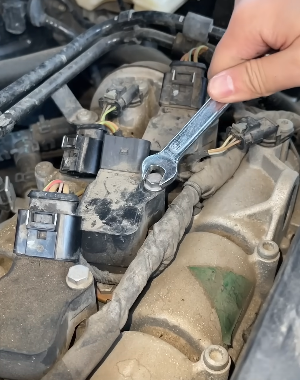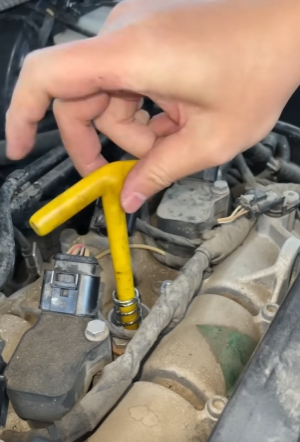
Few things are more frustrating than turning your car key or pressing the start button and realizing your car won’t start. Whether you’re on your way to work, school, or an important appointment, a non-starting car can disrupt your entire day. Fortunately, many of the common causes of this issue are easy to identify and, in some cases, fix yourself. This guide will walk you through the possible reasons why your car isn’t starting and the steps you can take to diagnose and solve the problem.

1. Check the Battery
One of the most common reasons a car won’t start is a dead or weak battery. If your dashboard lights are dim or don’t come on at all, or you hear a clicking sound when you turn the key, the battery may be the issue.
How to check:
- Turn on the headlights. If they are dim or don’t turn on, your battery might be dead.
- Try jump-starting the car using jumper cables and another vehicle.
- Use a multimeter to test the battery voltage. A healthy car battery should read around 12.6 volts when fully charged.
Solution:
- If a jump-start works, drive for at least 15-30 minutes to allow the alternator to recharge the battery.
- If the car still won’t start after being jumped, the battery might need replacing.
- Regularly check for corroded or loose battery terminals and clean them if necessary.
2. Listen for a Click or Silence
If you hear a clicking sound when you turn the key, but the engine doesn’t crank, it could indicate a problem with the starter motor or the starter solenoid.
How to check:
- Try tapping the starter gently with a tool. Sometimes this helps if there’s a dead spot.
- Make sure the battery is providing enough voltage. A weak battery can also prevent the starter from working properly.
Solution:
- If tapping the starter works temporarily, you’ll likely need a new starter.
- Consult a mechanic to confirm if the starter or solenoid is the issue.

3. Check the Fuel System
No fuel = no combustion = no start.
How to check:
- Listen for a humming sound near the fuel tank when you turn the key—this indicates the fuel pump is working.
- Ensure there is fuel in the tank (you’d be surprised how often this is overlooked).
- Check for clogged fuel filters or failed fuel pumps.
Solution:
- If the fuel pump is faulty, it may need to be replaced.
- Replace clogged fuel filters regularly as part of routine maintenance.
- Add fuel if you’re out!
4. Inspect the Ignition System
If the battery is fine and there’s fuel in the tank, the next thing to examine is the ignition system. Faulty spark plugs or ignition coils can prevent the engine from firing properly.
How to check:
- Remove a spark plug and inspect it. If it’s dirty, fouled, or damaged, that could be the problem.
- Use an ignition tester to check if a spark is being produced.
- Scan your vehicle with an OBD-II scanner to check for ignition-related error codes.
Solution:
- Replace old or worn spark plugs.
- Replace faulty ignition coils if needed.
- Make sure all plug wires are properly connected.

5. Check the Security System
Modern cars come equipped with anti-theft systems that can prevent the engine from starting if they detect a problem.
How to check:
- Look for a blinking security light on the dashboard.
- Make sure you’re using the correct key or key fob.
- Try locking and unlocking the car with the key fob to reset the system.
Solution:
- If your key fob battery is dead, replace it and try again.
- Some vehicles may need to be reset or reprogrammed. Refer to your car’s manual or consult a dealer.
6. Look at the Gear Shifter
If you’re driving an automatic transmission vehicle and it’s not in Park (P) or Neutral (N), the car won’t start.
How to check:
- Move the shifter to Park or Neutral and try again.
- Wiggle the gear shifter gently while turning the key.
Solution:
- A faulty neutral safety switch might be the issue and would need replacement.
- Make sure your car is properly in gear before attempting to start.
7. Examine the Fuses and Relays
Sometimes a blown fuse or a faulty relay can be the culprit, especially in vehicles with push-button starts or modern electronics.
How to check:
- Open the fuse box (usually under the hood or dashboard).
- Use the car’s manual to identify fuses related to the starter, ignition, or fuel systems.
- Inspect fuses for any signs of damage or breakage.
Solution:
- Replace any blown fuses with the same amperage rating.
- If the same fuse blows repeatedly, you may have a deeper electrical issue needing professional attention.

8. Check the Engine Immobilizer
An engine immobilizer is another anti-theft device that disables the engine unless the correct key is present. If your car doesn’t recognize the key, it may prevent starting.
How to check:
- Try a spare key if you have one.
- Check for dashboard warning lights or error messages.
Solution:
- Have the key reprogrammed at a dealership.
- In some cases, a faulty immobilizer control unit may need replacement.
9. Consider the Weather
Extreme cold or hot weather can affect your car’s ability to start, especially if your battery or fuel system is already weak.
Cold Weather Tips:
- Try turning off all accessories (radio, lights, AC) before starting.
- Turn the key to the “on” position for a few seconds before cranking to help warm the engine.
Hot Weather Tips:
- Heat can cause vapor lock in older vehicles with carburetors.
- Let the car sit in the shade or open the hood to let the engine cool down.
10. Call for Help
If you’ve tried all the above and your car still won’t start, it might be time to call for roadside assistance or a trusted mechanic.
When to call:
- You smell fuel or see leaking fluid.
- You hear unusual noises like grinding or whining.
- You’re stuck in a dangerous or unfamiliar location.
Solution:
- Use your roadside assistance membership or call a towing service.
- Take your car to a reputable repair shop for a full diagnostic.

Conclusion
A car that won’t start can be caused by a wide range of issues—from a dead battery to a failed fuel pump or a security system glitch. By following a systematic approach and checking each component step by step, you can often identify and resolve the problem quickly. While some issues require professional repair, many can be diagnosed or even fixed with basic tools and a bit of knowledge.
To prevent future issues, be proactive: maintain your battery, replace spark plugs on schedule, and pay attention to how your car behaves. With these tips, you’ll be better prepared to handle the frustrating situation of a car that won’t start.


